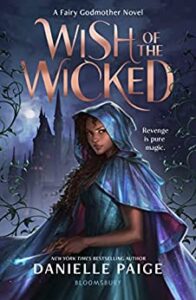Wish of the Wicked
Danielle Paige
Bloomsbury
November 14, 2023
Amazon | Bookshop | Goodreads
About Wish of the Wicked
Bestselling author Danielle Paige puts a dark spin on fairy godmothers in a new YA series for fans of Brigid Kemmerer and Maleficent.
For centuries, the enchanted members of the Entente have worked in tandem with the Three Fates—the Present, the Past, and the Future—to maintain destiny across the Thirteen Queendoms. But when Queen Magrit learns of her untimely demise from Hecate, Fate of the Future, Magrit burns Hecate at the stake and decrees death to all Entente in order to live forever.
But some survive, including sixteen-year-old Farrow, who hatches a dangerous plan to seek revenge. Along the way, she finds herself falling for the one person who could ruin everything. With life and love hanging in the balance, she must decide who to trust and what’s most important: living in the past or forging a new future.
Bestselling author Danielle Paige launches a brand-new fairy godmother origin story full of intrigue, magic, and romance.
My Review
I found the pacing of this one a little different than I expected. Sometimes an origin story takes us right up to the beginning of a familiar tale, or right up to a character’s involvement in a familiar tale. I expected something like that here. To follow Farrow’s story until she meets a crying girl in a wrecked dress who just wants to go to the ball.
Instead, about half of the book tells Farrow’s history, relating how she has magic, what happened to drive her to the palace, and why she’s interested in helping Cinderella in the first place. The second half basically tells the story of Cinderella, but from the fairy godmother’s point-of-view.
My favorite parts of the book were how the setup changed or reflected the story of Cinderella. I really liked the setup involving Cinderella’s step-family. That reflected the original story and turned it around completely differently. It created connections between the fairy godmother and the family that added a lot of interest and stakes.
I also expected a lot more romance in the book. There are a couple of kissing scenes, but they’re mostly performative, and Farrow spends so much time focused on revenge and survival that she barely spares a thought to her feelings about a certain boy. It’s possible that the romance develops more in a subsequent book in the series, though.
All in all, I thought this was an imaginative origin story/retelling with some clever changes to the original tale. Fairy tale readers will like getting the often-overlooked perspective of the fairy godmother in a female-dominated cast.
Content Notes
Recommended for Ages 14 up.
Representation
Farrow is described as having light brown skin.
Profanity/Crude Language Content
Mild profanity used somewhat infrequently.
Romance/Sexual Content
Kissing between boy and girl. At one point, a boy’s friends tease him and ask him to have Farrow disrobe in front of them as part of the aftermath of a ceremony where she’s presented to him. She obliges, down to her undergarments.
Spiritual Content
Some characters have magic. Three of the Entente have the ability to see events: past, present, or future. Some characters refer to Fate as a source of power or guidance.
Violent Content
Situations of peril. Some brief descriptions of women being burned alive or drowned. A few scenes contain some body horror, in which a person’s body transforms into beetles, bees, or scorpions. Soldiers attack using magic-suppressing weapons.
Drug Content
None.
Note: This post contains affiliate links, which do not cost you anything but help support this blog. I received a free copy of WISH OF THE WICKED in exchange for my honest review.
